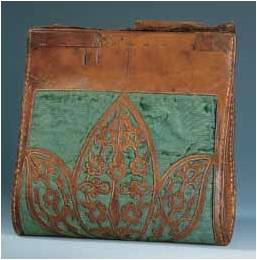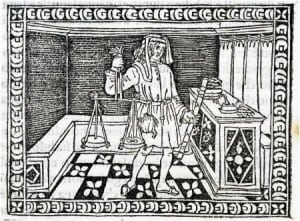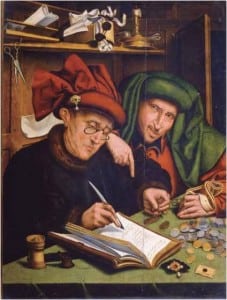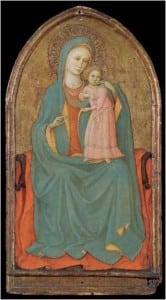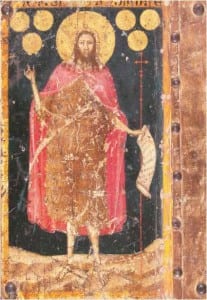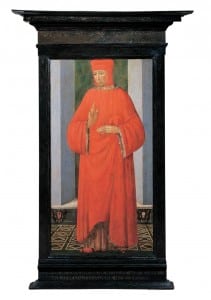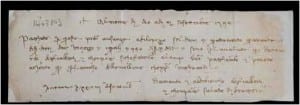
In a few handwritten lines, this is the financial instrument that revolutionized banking. A merchant in Bruges owing money in Barcelona pays into a local bank which sends this bill to its contact bank in Barcelona which pays out the money, in local currency, to the merchant’s creditor. As many as four copies were made and sent
separately to make sure of safe arrival. The only problem now was balancing the accounts between the two banks.
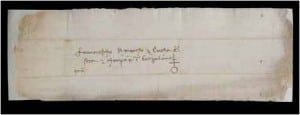
Poche righe scritte a mano: ecco lo strumento finanziario che rivoluzionò l’attività bancaria. Un mercante di Bruges, dovendo dei soldi a Barcellona, li versa in una banca del posto; questa spedisce la lettera a una banca di appoggio a Barcellona che corrisponde la somma al creditore del mercante, in valuta locale. Se ne stilavano quattro copie, inviate separatamente per garantirne l’arrivo. Ora il solo problema era pareggiare i conti tra le due banche.
Category Archives: unkategorisiert
Couriers before the Net…
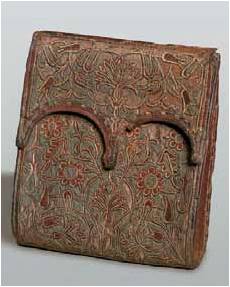 «Lettere di qui a Vinega» scrive un agente da Milano nel 1395 «fate chonto che ongni domenicha mattina ci va per reghola 1 fante e di qui a Bruga, chome, le scarselle da Lucha là passano per qui e chosì per Parigi». L’informazione era l’anima del commercio. I banchieri indicavano in ogni lettera i tassi di cambio del giorno. I corrieri erano organizzati da corporazioni o consorzi di aziende, e ricompensati per la rapidità di consegna. Il mondo stava affrettando il passo.
«Lettere di qui a Vinega» scrive un agente da Milano nel 1395 «fate chonto che ongni domenicha mattina ci va per reghola 1 fante e di qui a Bruga, chome, le scarselle da Lucha là passano per qui e chosì per Parigi». L’informazione era l’anima del commercio. I banchieri indicavano in ogni lettera i tassi di cambio del giorno. I corrieri erano organizzati da corporazioni o consorzi di aziende, e ricompensati per la rapidità di consegna. Il mondo stava affrettando il passo.
“About letters from here to Venice,” writes an agent in Milan in 1395 “you can reckon on one horseman leaving every Sunday morning, likewise for Bruges. The courier from Luca passes here on his way to Paris.” Regular information was essential for commerce. Bankers would list the day’s exchange rates at the end of every letter. Courier services were organized by guilds or consortiums of companies and rewarded for rapid delivery. The world was speeding up.
Crowning the Madonna
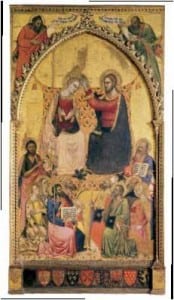
L’Incoronazione della Vergine consente al committente di cingere
d’oro la testa della Madonna. Era un soggetto caro ai mercanti
banchieri della Firenze rinascimentale. Qui la Zecca fiorentina
commissiona un’immagine del regno di Dio, i cui valori sono
sublimi e indivisibili, per ornare un edificio nel quale si forgia
denaro contante.
The Coronation of the Virgin gives you a chance to put gold on the
Madonna’s head. It was a favorite subject for the money men of
Renaissance Florence. Here, the Florence Mint commissions an image
of the sacred realm where values are sublime and indivisible to
grace a building that produces countable cash.
Under the Wing of an Archangel. A young banker abroad.
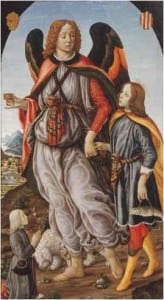 Non appena sapeva usare penna e abaco, il figlio di un mercante
Non appena sapeva usare penna e abaco, il figlio di un mercante
cominciava l’apprendistato in una città lontana per «cercare un
poco del mondo […] e’ regimenti e le condizioni de’ luoghi» e
tornare «più isperto e più pratico d’ogni cosa». Frattanto i genitori
imploravano ansiosi l’assistenza divina, in questo caso pagando
una bella somma per evocare la protezione dell’arcangelo su
Tobia, una storia dal Libro di Tobit. Ahimè il ragazzo in questione,
probabilmente Raffaello Doni, figlio di ricchi mercanti di lana,
morì nel 1487, a 14 anni.
No sooner had he mastered pen and abacus than a merchant’s boy
would be on his way to an apprenticeship in a distant town where he
should “seek out a little of the world […] the customs and conditions
of places” and come back “more expert and practical in everything”.
Meantime the anxious parents implored divine protection, in this case
paying handsomely to evoke the archangel’s protection of Tobias, a story in The Book of Tobit. Alas, the boy in question, most likely Raffaello Doni, son of wealthy wool merchants, died in 1487 aged 14.
Weights, measures and a game of chess
Non facevano che pesare e misurare, e sempre con aria di grande solennità, come fosse una questione di somma importanza. Questo libro paragona ogni ruolo sociale a un pezzo degli scacchi, celebrando una società gerarchica in cui ciascuno ha una posizione fissa. In realtà la speculazione commerciale stava rendendo più
fluida la società: qui il banchiere è annoverato fra i pedoni,ma negli scacchi alcuni pedoni assurgono a reali.
Merchants and bankers were forever weighing and measuring, and with an air of great solemnity, as if something terribly important were at stake. This book likens each social role to a different chess piece, celebrating a hierarchical society where everyone has a fixed position. In reality commercial speculation was making society more fluid: the banker is included among the pawns, but in chess some pawns are transformed into royalty.
Ugly Money – Usurers, Quenten Metsys
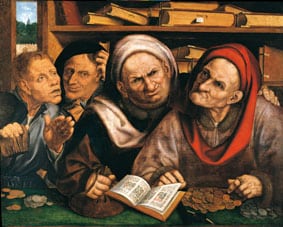
La bruttezza spirituale stampata in faccia come una testa
su una moneta. La società accalcata e divisa di fronte
a un mucchio di soldi e al mistero della moltiplicazione
del denaro tramite incrementi d’interesse calcolati con precisione.
Era da un’immagine del genere che i mercanti-banchieri
rinascimentali cercavano di distanziarsi investendo i loro guadagni
nella bellezza e asservendola alla chiesa e ai santi.
Spiritual ugliness stamped in the physiognomy as surely as a head
upon a coin. Society crowds and divides around the heap of cash
and the mystery of money multiplying in carefully calculated
increments of interest. It was from this sort of vision that the
merchant bankers of the Renaissance sought to distance themselves when they invested their profits in beauty and laid it at the feet of church and saints.
They were always writing – The Usurers, Marinus van Reymerswaele
Avevano sempre la penna in mano. «Sono ore 21» dice Datini
«e non ò mangiato né bevuto e sono stato uno dì a sedere che mai
sono uscito di casa, e sono per istare insino a sera sanza mangiare
e domane sono per fare il simile». Qui l’artista aspira a catturare
un tale fanatismo, con l’implicazione che il godimento dell’usuraio
stava nel suo ossessivo annotare, calcolare e gongolare, il corpo
curvo e teso sopra una penna in costante movimento.
They were always writing. “It is the ninth hour,” says Datini “
and I have not yet eaten nor drunk, and I have been seated all day,
without ever going out, and shall not eat until tonight… tomorrow
I intend to do the same.” Here the painter looks to capture this
fanatic mind-set, with the implication that the usurer’s enjoyment
lay in obsessive recording, calculating and gloating, the body
curved and constrained over the constantly moving pen.
The Madonna Trade – Money and Beauty at Palazzo Strozzi
Fra Angelico “could have become rich, but made no effort to do so.” So Vasari tells us. Instead he painted for the wealthy. Privately commisioned, this painting was intended to enhance the quality of a rich man’s prayers. The viewer is not reminded that Christ was born in poverty. Francesco Datini advised agents procuring devotional paintings to wait until artists were in need of money, then talk down their prices.
Blue paint: 2 florins (approx). Gold background: 38 florins (approx). Artist’s work: 35 florins (approx)
Fra Angelico «potette essere ricco, e non se ne curò». Così dice Vasari. Si limitò a dipingere per i ricchi. Commissionata da un privato, quest’opera doveva esaltare la qualità delle preghiere del facoltoso cliente, cui non andavano ricordate le umili origini del Cristo. Francesco Datini suggerì agli agenti incaricati di procurare dipinti votivi, di aspettare che gli artisti avessero bisogno di soldi e poi tirare sul prezzo.
Azzuro ultramarino: 2 fiorini circa. Sfondo dorato: 38 fiorini circa. Opera dell’artista: 35 fiorini circa
Statute of the Florence Mint
Halos and coins. The biblical John the Baptist lived in poverty wearing a raiment of camel’s hair. The Florence mint adds the scarlet cloak of wealth and authority. As patron saint of Florence, he would feature on every florin the mint produced. It was comforting to see no conflict between money and sanctity. The statute contains regulations to prevent cheating and forgery, plus details of those condemned for these crimes between 1314 and 1461.
Aureole e monete. Il Giovanni Battista biblico viveva in povertà indossando una veste di peli di cammello. La Zecca fiorentina lo ammanta anche di scarlatto, simbolo di ricchezza e autorità. Come santo patrono di Firenze figurava su ogni fiorino coniato dalla Zecca. Una confortante fusione tra soldi e santità. Lo statuto contiene le norme atte a prevenire frodi e contraffazioni, oltre ai dettagli dei condannati per questi reati tra il 1314 e il 1461.
The Merchant of Prato
A man “who kept women and lived only on partridges, adoring art and money and forgetting his creator and himself”. Over his long life the workaholic Merchant of Prato, Francesco Datini, must have set a price on every commodity imaginable, including the 20-year-old slave who bore him the only child he recognized: Ginevra. At his death in 1410, he left 124,549 business letters, 573 account books, and a fortune of over 100,000 florins. The scarlet gown cost around 80 florins, rather more than the slave girl.
Tim Parks
Un uomo «che tenea la femmina, e viveano solo a starne, adorando lo’ arte, lo’ invio e ’l danaro, dimenticando Iddio e se stesso», Francesco Datini, l’infaticabile mercante di Prato, nella sua lunga vita fissò un prezzo per ogni bene immaginabile, compresa la schiava ventenne che gli diede l’unica figlia che riconobbe: Ginevra. Morì nel 1410 lasciando 124.549 lettere d’affari, 573 libri contabili e una fortuna di oltre 100.000 fiorini. La veste scarlatta sarà costata circa 80 fiorini, ben più della schiava.

